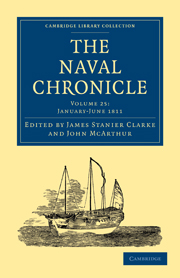 The Naval Chronicle
The Naval Chronicle Published online by Cambridge University Press: 10 January 2011
The period at which Sir Erasmus Gower's biographer concluded the detail of that officer's services, was not the termination of his professional career. On the 9th of February, 1801, he hoisted his flag, as rear-admiral of the white squadron, in the Princess Royal, of 98 guns, and joined the Channel fle t, then under the command of Admiral Cornwallis. During this year, the preliminaries of peace with France were signed; and, on the 13th of the ensuing February (1802) when, in expectancy of the memorable treaty of Amiens, preparations were making for the reduction of our naval establishment, Sir Erasmus struck his flag.
From that time, he remained unemployed until the 21st of May, 1804; when, as vice-admiral of the white, to which rank he had been promoted on the 23d of the preceding April, he was appointed commander-in-chief and governor of Newfoundland. This highly responsible command he held until the 12th of March, 1807, being the full term of three years, for which it is usually delegated. During this service he obtained the rank of vice-admiral of the red; an event which took place on the 9th of April, 1805. The Isis, of 50 guns, bore his flag the whole period of his command.
The government of Newfoundland was peculiarly adapted to the disposition and character of Sir Erasmus Gower, as affording a full opportunity for the display of that beneficence and philanthropy which he so eminently possesses.
To save this book to your Kindle, first ensure [email protected] is added to your Approved Personal Document E-mail List under your Personal Document Settings on the Manage Your Content and Devices page of your Amazon account. Then enter the ‘name’ part of your Kindle email address below. Find out more about saving to your Kindle.
Note you can select to save to either the @free.kindle.com or @kindle.com variations. ‘@free.kindle.com’ emails are free but can only be saved to your device when it is connected to wi-fi. ‘@kindle.com’ emails can be delivered even when you are not connected to wi-fi, but note that service fees apply.
Find out more about the Kindle Personal Document Service.
To save content items to your account, please confirm that you agree to abide by our usage policies. If this is the first time you use this feature, you will be asked to authorise Cambridge Core to connect with your account. Find out more about saving content to Dropbox.
To save content items to your account, please confirm that you agree to abide by our usage policies. If this is the first time you use this feature, you will be asked to authorise Cambridge Core to connect with your account. Find out more about saving content to Google Drive.